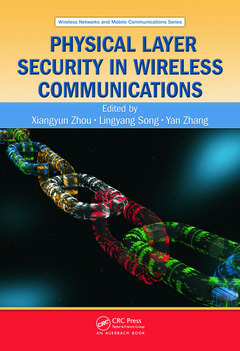Description
Physical Layer Security in Wireless Communications
Wireless Networks and Mobile Communications Series
Coordinators: Zhou Xiangyun, Song Lingyang, Zhang Yan
Language: English
Subjects for Physical Layer Security in Wireless Communications:
Keywords
Physical Layer Security; Wiretap Channel; wiretap; Cooperative Jamming; channel; Achievable Secrecy Rate; secrecy; Secrecy Rate; rate; Friendly Jammer; cooperative; Polar Codes; jamming; Large Wireless Networks; legitimate; Gaussian Wiretap Channel; receiver; Outage Probability; network; Sop; mutual; Malicious Eavesdropper; Optimal Power Allocation; Legitimate Receiver; SNR Loss; Power Allocation; Average Power Constraint; Relay Nodes; Ra Te; LDPC Code; OFDMA Network; Key Rate; Conventional Relay; Eavesdropper Locations; Secret Key Generation
Support: Print on demand
Description
/li>Contents
/li>Readership
/li>Biography
/li>
Physical layer security has recently become an emerging technique to complement and significantly improve the communication security of wireless networks. Compared to cryptographic approaches, physical layer security is a fundamentally different paradigm where secrecy is achieved by exploiting the physical layer properties of the communication system, such as thermal noise, interference, and the time-varying nature of fading channels.
Written by pioneering researchers, Physical Layer Security in Wireless Communications supplies a systematic overview of the basic concepts, recent advancements, and open issues in providing communication security at the physical layer. It introduces the key concepts, design issues, and solutions to physical layer security in single-user and multi-user communication systems, as well as large-scale wireless networks.
The book starts with a brief introduction to physical layer security. The rest of the book is organized into four parts based on the different approaches used for the design and analysis of physical layer security techniques:
- Information Theoretic Approaches: introduces capacity-achieving methods and coding schemes for secure communication, as well as secret key generation and agreement over wireless channels
- Signal Processing Approaches: covers recent progress in applying signal processing techniques to design physical layer security enhancements
- Game Theoretic Approaches: discusses the applications of game theory to analyze and design wireless networks with physical layer security considerations
- Graph Theoretic Approaches: presents the use of tools from graph theory and stochastic geometry to analyze and design large-scale wireless networks with physical layer security constraints
Presenting high-level discussions along with specific examples, illustrations, and references to conference and journal articles, this is an ideal reference for postgraduate students, researchers, and engineers that need to obtain a macro-level understanding of physical layer security and its role in future wireless communication systems.
Fundamentals of Physical Layer Security. Coding for Wiretap Channels. LDPC Codes for the Gaussian Wiretap Channel. Key Generation From Wireless Channels. Secrecy With Feedback. MIMO Signal Processing Algorithms for Enhanced Physical Layer Security. Discriminatory Channel Estimation for Secure Wireless Communication. Physical Layer Security in OFDMA Networks. The Application of Cooperative Transmissions to Secrecy Communications. Game Theory for Physical Layer Security on Interference Channels. Ascending Clock Auction for Physical Layer Security. Relay and Jammer Cooperation as a Coalitional Game. Stochastic Geometry Approaches to Secrecy in Large Wireless Networks. Physical Layer Secrecy in Large Multi-Hop Wireless Networks.
Xiangyun Zhou is a Lecturer at the Australian National University. He received the B.E. (hons.) degree in electronics and telecommunications engineering and the Ph.D. degree in telecommunications engineering from the ANU in 2007 and 2010, respectively. From June 2010 to June 2011, he worked as a postdoctoral fellow at UNIK - University Graduate Center, University of Oslo, Norway. His research interests are in the fields of communication theory and wireless networks, including MIMO systems, relay and cooperative communications, heterogeneous and small cell networks, ad hoc and sensor wireless networks, physical layer security, and wireless power transfer. Dr. Zhou serves on the editorial boards of Security and Communication Networks (Wiley) and Ad Hoc & Sensor Wireless Networks. He was the organizer and chair of the special session on "Stochastic Geometry and Random Networks" in 2013 Asilomar Conference on Signals, Systems, and Computers. He has also served as the TPC member of major IEEE conferences. He is a recipient of the Best Paper Award at the 2011 IEEE International Conference on Communications.
Lingyang Song is a Professor at Peking University, China. He received his PhD from the University of York, UK, in 2007, where he received the K. M. Stott Prize for excellent research. He worked as a postdoctoral research fellow at the University of Oslo, Norway, and Harvard University, until rejoining Philips Research UK in March 2008. In May 2009, he joined the School of Electronics Engineering and Computer Science, Peking University, China, as a full professor. His main research interests include MIMO, OFDM, cooperative communications, cognitive radio, physical layer security, game theory, and wireless ad hoc/sensor networks. He is co-inventor of a number of patents (standard contributions), and author or co-author of over 100 journal and conference papers. He is the co-editor of two books, "Orthogonal Frequency Divisi




